嵌入式LAB 1:启动
2016-06-20 16:11
239 查看
嵌入式系统Lab 1 启动
1、 画出你所实际实施的连接示意图
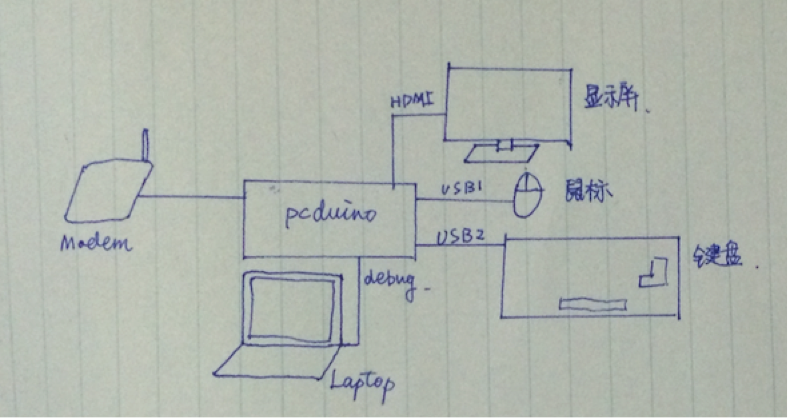
2、给出实际拍摄的板卡连接照片
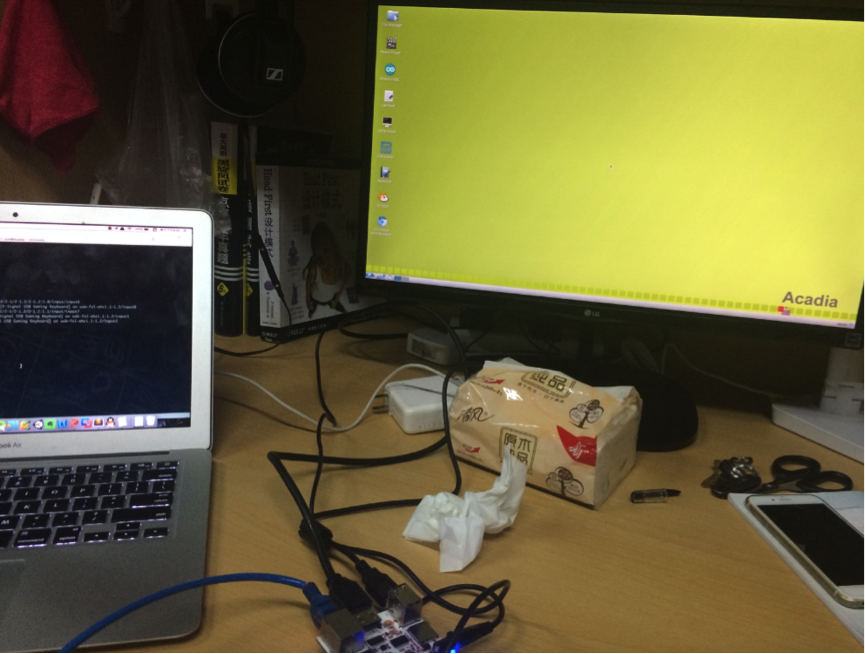
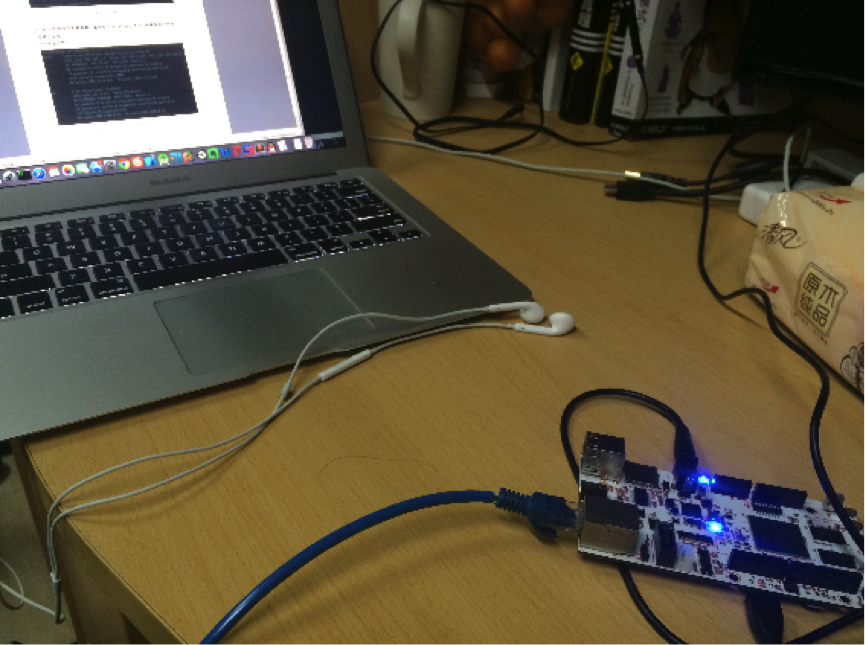
3、给出所用的器材的列表
pcduino(含电源)、USB串口线、网线、SD卡、无线网卡显示屏、鼠标、键盘、支持L2TP路由器、MacBook Air
4、给出得到的pcDuino启动时的输出文字,并逐行解释
U-Boot 2009.08 (Dec 25 2014 - 21:37:33) # U-Boot: Universal Boot Loader, 负责嵌入式 Linux 系统的引导 CPU: Freescale i.MX6 family TO1.2 at 792 MHz # CPU 型号 Thermal sensor with ratio = 172 # 温度传感器 Temperature: 35 C, calibration data 0x5404c169 # 温度刻度 mx6q pll1: 792MHz # 处理器主频 mx6q pll2: 528MHz # 处理器主频 mx6q pll3: 480MHz # 处理器主频 mx6q pll8: 50MHz # 处理器主频 ipg clock : 66000000Hz #ipg per clock : 66000000Hz uart clock : 80000000Hz # Universal Asynchronous Receiver/Transmitter, 通用异步收发传输器 cspi clock : 60000000Hz ahb clock : 132000000Hz # Advanced High Performance Bus, 高级高性能总线 axi clock : 264000000Hz # Advanced eXtensible Interface, 一种总线协议 emi_slow clock: 132000000Hz ddr clock : 528000000Hz # Double Data Rate, 双倍速率同步动态随机存储器 usdhc1 clock : 198000000Hz usdhc2 clock : 198000000Hz usdhc3 clock : 198000000Hz usdhc4 clock : 198000000Hz nfc clock : 24000000Hz Board: i.MX6Q-SABRESD: unknown-board Board: 0x63012 [POR ] # 主板 Boot Device: MMC # 引导设备 I2C: ready # 集成电路总线 DRAM: 1 GB # Dynamic Random Access Memory, 动态随机存储器 MMC: FSL_USDHC: 0,FSL_USDHC: 1,FSL_USDHC: 2,FSL_USDHC: 3 # Multimedia Card, 多媒体记忆卡 In: serial # 正常输入 Out: serial # 正常输出 Err: serial # 错误信息, 3者都在串口上 config_ipu_di_clk: freq = 148500000. wait for pll5 lock. config_ipu_di_clk: set pll5 clock to 297000000Hz. Found PFUZE100! deviceid=10,revid=11 Net: got MAC address from IIM: 00:00:00:00:00:00 # 获得 MAC 地址 FEC0 [PRIME] Hit any key to stop autoboot: 0 # 在这里敲任意键可以停止自动引导, 0代表没有敲 mmc3(part 0) is current device # 在MMC3上进行以下操作 MMC read: dev # 3, block # 2048, count 10240 ... 10240 blocks read: OK # 检查读写, 成功 ## Booting kernel from Legacy Image at 10800000 ... # 引导内核, 从一个固定的地址开始 Image Name: Linux-3.0.35-2666-gbdde708 # 映像名 Image Type: ARM Linux Kernel Image (uncompressed) # 映像类型 Data Size: 4422312 Bytes = 4.2 MB # 数据大小 Load Address: 10008000 # 装载地址 Entry Point: 10008000 # 引导进入点 Verifying Checksum ... OK # 验证 Checksum, 成功 Loading Kernel Image ... OK # 装载内核映像 OK Starting kernel ... # 启动内核 Uncompressing Linux... done, booting the kernel. # 内核的解压,引导,内核版本信息 Linux version 3.0.35-2666-gbdde708 (root@ubuntu) (gcc version 4. 4000 6.3 (Ubuntu/Linaro 4.6.3-1ubuntu5) ) #218 SMP PREEMPT Thu Dec 18 22:32:36 PST 2014 CPU: ARMv7 Processor [412fc09a] revision 10 (ARMv7), cr=10c53c7d # CPU 信息 CPU: VIPT nonaliasing data cache, VIPT aliasing instruction cache # CPU 对缓存区的判别 Machine: Freescale i.MX 6Quad/DualLite/Solo Sabre-SD Board # 主要硬件, 如处理器/主板等 Memory policy: ECC disabled, Data cache writealloc # 内存策略 CPU identified as i.MX6Q, silicon rev 1.2 # 具体的 CPU 识别 PERCPU: Embedded 7 pages/cpu @8c008000 s5472 r8192 d15008 u32768 # Per-CPU信息, Per-CPU 用来解决 CPU 之间同步问题 Built 1 zonelists in Zone order, mobility grouping on. Total pages: 194560 Kernel command line: console=ttymxc0,115200 root=/dev/mmcblk0p1 rootwait fec_mac=4c:53:1e:15:61:d4 video=mxcfb0:dev=hdmi,1920x1080M@60,if=RGB24,bpp=32 fbmem=28M PID hash table entries: 4096 (order: 2, 16384 bytes) Dentry cache hash table entries: 131072 (order: 7, 524288 bytes) Inode-cache hash table entries: 65536 (order: 6, 262144 bytes) Memory: 512MB 256MB = 768MB Total # 内存大小 Memory: 764648k/764648k available, 283928k reserved, 0K highmem # 内存的状态 Virtual kernel memory layout: # 虚拟内存的布局和大小 vector : 0xffff0000 - 0xffff1000 ( 4 kB) fixmap : 0xfff00000 - 0xfffe0000 ( 896 kB) DMA : 0xf4600000 - 0xffe00000 ( 184 MB) vmalloc : 0xc0800000 - 0xf2000000 ( 792 MB) lowmem : 0x80000000 - 0xc0000000 (1024 MB) pkmap : 0x7fe00000 - 0x80000000 ( 2 MB) modules : 0x7f000000 - 0x7fe00000 ( 14 MB) .init : 0x80008000 - 0x8003e000 ( 216 kB) .text : 0x8003e000 - 0x80b93ca8 (11608 kB) .data : 0x80b94000 - 0x80bff600 ( 430 kB) .bss : 0x80bff624 - 0x80c58d0c ( 358 kB) SLUB: Genslabs=13, HWalign=32, Order=0-3, MinObjects=0, CPUs=4, Nodes=1 # SLUB 分配器的参数, SLUB 是内核里面分配小内存的策略 Preemptible hierarchical RCU implementation. # 可抢先式内核 NR_IRQS:624 # IRQ 的最大数目 MXC GPIO hardware sched_clock: 32 bits at 3000kHz, resolution 333ns, wraps every 1431655ms arm_max_freq=1GHz MXC_Early serial console at MMIO 0x2020000 (options '115200') bootconsole [ttymxc0] enabled Console: colour dummy device 80x30 Calibrating delay loop... 1581.05 BogoMIPS (lpj=7905280) pid_max: default: 32768 minimum: 301 Mount-cache hash table entries: 512 CPU: Testing write buffer coherency: ok hw perfevents: enabled with ARMv7 Cortex-A9 PMU driver, 7 counters available CPU1: Booted secondary processor CPU2: Booted secondary processor CPU3: Booted secondary processor Brought up 4 CPUs SMP: Total of 4 processors activated (6324.22 BogoMIPS). print_constraints: dummy: NET: Registered protocol family 16 print_constraints: vddpu: 725 <--> 1300 mV at 700 mV fast normal print_constraints: vddcore: 725 <--> 1300 mV at 1150 mV fast normal print_constraints: vddsoc: 725 <--> 1300 mV at 1200 mV fast normal print_constraints: vdd2p5: 2000 <--> 2775 mV at 2400 mV fast normal print_constraints: vdd1p1: 800 <--> 1400 mV at 1100 mV fast normal print_constraints: vdd3p0: 2625 <--> 3400 mV at 3000 mV fast normal hw-breakpoint: found 6 breakpoint and 1 watchpoint registers. hw-breakpoint: 1 breakpoint(s) reserved for watchpoint single-step. hw-breakpoint: maximum watchpoint size is 4 bytes. L310 cache controller enabled l2x0: 16 ways, CACHE_ID 0x410000c7, AUX_CTRL 0x02070000, Cache size: 1048576 B bio: create slab <bio-0> at 0 mxs-dma mxs-dma-apbh: initialized print_constraints: SPKVDD: 4200 mV print_constraints: vmmc: 3300 mV SCSI subsystem initialized spi_imx imx6q-ecspi.0: probed spi_imx imx6q-ecspi.2: probed usbcore: registered new interface driver usbfs usbcore: registered new interface driver hub usbcore: registered new device driver usb Freescale USB OTG Driver loaded, $Revision: 1.55 $ set the i2c clk:100000 Hz # 设置总线 mc_pfuze 1-0008: ID: 0,Full lay: 1 ,Metal lay: 1 mc_pfuze 1-0008: FAB: 0 ,FIN: 0 print_constraints: PFUZE100_SW1A: 300 <--> 1875 mV at 1300 mV print_constraints: PFUZE100_SW1B: 300 <--> 1875 mV at 300 mV print_constraints: PFUZE100_SW1C: 300 <--> 1875 mV at 1300 mV print_constraints: PFUZE100_SW2: 800 <--> 3950 mV at 3300 mV print_constraints: PFUZE100_SW3A: 400 <--> 1975 mV at 1500 mV print_constraints: PFUZE100_SW3B: 400 <--> 1975 mV at 1500 mV print_constraints: PFUZE100_SW4: 800 <--> 3950 mV at 3150 mV print_constraints: PFUZE100_SWBST: 5000 <--> 5150 mV at 5000 mV print_constraints: PFUZE100_VSNVS: 1200 <--> 3000 mV at 1800 mV print_constraints: PFUZE100_VREFDDR: at 750 mV print_constraints: PFUZE100_VGEN1: 800 <--> 1550 mV at 1500 mV print_constraints: PFUZE100_VGEN2: 800 <--> 1550 mV at 1500 mV print_constraints: PFUZE100_VGEN3: 1800 <--> 3300 mV at 2800 mV print_constraints: PFUZE100_VGEN4: 1800 <--> 3300 mV at 1800 mV print_constraints: PFUZE100_VGEN5: 1800 <--> 3300 mV at 3000 mV print_constraints: PFUZE100_VGEN6: 1800 <--> 3300 mV at 3300 mV imx-ipuv3 imx-ipuv3.0: IPU DMFC NORMAL mode: 1(0~1), 5B(4,5), 5F(6,7) imx-ipuv3 imx-ipuv3.1: IPU DMFC NORMAL mode: 1(0~1), 5B(4,5), 5F(6,7) mxc_mipi_csi2 mxc_mipi_csi2: i.MX MIPI CSI2 driver probed mxc_mipi_csi2 mxc_mipi_csi2: i.MX MIPI CSI2 dphy version is 0x3130302a MIPI CSI2 driver module loaded Advanced Linux Sound Architecture Driver Version 1.0.24. Bluetooth: Core ver 2.16 NET: Registered protocol family 31 Bluetooth: HCI device and connection manager initialized Bluetooth: HCI socket layer initialized Bluetooth: L2CAP socket layer initialized Bluetooth: SCO socket layer initialized cfg80211: Calling CRDA to update world regulatory domain i2c-core: driver [max17135] using legacy suspend method i2c-core: driver [max17135] using legacy resume method Switching to clocksource mxc_timer1 FS-Cache: Loaded NET: Registered protocol family 2 IP route cache hash table entries: 32768 (order: 5, 131072 bytes) TCP established hash table entries: 131072 (order: 8, 1048576 bytes) TCP bind hash table entries: 65536 (order: 7, 786432 bytes) TCP: Hash tables configured (established 131072 bind 65536) TCP reno registered UDP hash table entries: 512 (order: 2, 16384 bytes) UDP-Lite hash table entries: 512 (order: 2, 16384 bytes) NET: Registered protocol family 1 RPC: Registered n 1370d amed UNIX socket transport module. RPC: Registered udp transport module. RPC: Registered tcp transport module. RPC: Registered tcp NFSv4.1 backchannel transport module. PMU: registered new PMU device of type 0 Static Power Management for Freescale i.MX6 wait mode is enabled for i.MX6 cpaddr = c0880000 suspend_iram_base=c0934000 PM driver module loaded IMX usb wakeup probe add wake up source irq 75 IMX usb wakeup probe cpu regulator mode:ldo_bypass _regulator_get: get() with no identifier mx6_cpu_regulator_init: failed to get pu regulator i.MXC CPU frequency driver nfs4filelayout_init: NFSv4 File Layout Driver Registering... Installing knfsd (copyright (C) 1996 okir@monad.swb.de). NTFS driver 2.1.30 [Flags: R/W]. # ntfs 驱动 JFFS2 version 2.2. (NAND) ?? 2001-2006 Red Hat, Inc. fuse init (API version 7.16) msgmni has been set to 1493 alg: No test for stdrng (krng) io scheduler noop registered io scheduler deadline registered io scheduler cfq registered (default) mxc_mipi_dsi mxc_mipi_dsi: i.MX MIPI DSI driver probed MIPI DSI driver module loaded mxc_sdc_fb mxc_sdc_fb.0: register mxc display driver hdmi mxc_hdmi mxc_hdmi: Detected HDMI controller 0x13:0xa:0xa0:0xc1 fbcvt: 1920x1080@60: CVT Name - 2.073M9 imx-ipuv3 imx-ipuv3.0: IPU DMFC DP HIGH RESOLUTION: 1(0,1), 5B(2~5), 5F(6,7) Console: switching to colour frame buffer device 240x67 mxc_sdc_fb mxc_sdc_fb.1: register mxc display driver ldb _regulator_get: get() with no identifier mxc_sdc_fb mxc_sdc_fb.2: register mxc display driver lcd mxc_sdc_fb mxc_sdc_fb.2: ipu0-di0 already in use mxc_sdc_fb: probe of mxc_sdc_fb.2 failed with error -16 mxc_sdc_fb mxc_sdc_fb.3: register mxc display driver ldb imx-sdma imx-sdma: loaded firmware 1.1 imx-sdma imx-sdma: initialized Serial: IMX driver # 串行驱动 imx-uart.2: ttymxc2 at MMIO 0x21ec000 (irq = 60) is a IMX imx-uart.0: ttymxc0 at MMIO 0x2020000 (irq = 58) is a IMX console [ttymxc0] enabled, bootconsole disabled console [ttymxc0] enabled, bootconsole disabled loop: module loaded # 载入环回设备模块 No sata disk. GPMI NAND driver registered. (IMX) vcan: Virtual CAN interface driver CAN device driver interface flexcan netdevice driver FEC Ethernet Driver # 网驱 fec_enet_mii_bus: probed ehci_hcd: USB 2.0 'Enhanced' Host Controller (EHCI) Driver fsl-ehci fsl-ehci.0: Freescale On-Chip EHCI Host Controller fsl-ehci fsl-ehci.0: new USB bus registered, assigned bus number 1 fsl-ehci fsl-ehci.0: irq 75, io base 0x02184000 fsl-ehci fsl-ehci.0: USB 2.0 started, EHCI 1.00 usb usb1: New USB device found, idVendor=1d6b, idProduct=0002 usb usb1: New USB device strings: Mfr=3, Product=2, SerialNumber=1 usb usb1: Product: Freescale On-Chip EHCI Host Controller usb usb1: Manufacturer: Linux 3.0.35-2666-gbdde708 ehci_hcd usb usb1: SerialNumber: fsl-ehci.0 hub 1-0:1.0: USB hub found hub 1-0:1.0: 1 port detected add wake up source irq 72 fsl-ehci fsl-ehci.1: Freescale On-Chip EHCI Host Controller fsl-ehci fsl-ehci.1: new USB bus registered, assigned bus number 2 fsl-ehci fsl-ehci.1: irq 72, io base 0x02184200 fsl-ehci fsl-ehci.1: USB 2.0 started, EHCI 1.00 usb usb2: New USB device found, idVendor=1d6b, idProduct=0002 usb usb2: New USB device strings: Mfr=3, Product=2, SerialNumber=1 usb usb2: Product: Freescale On-Chip EHCI Host Controller usb usb2: Manufacturer: Linux 3.0.35-2666-gbdde708 ehci_hcd usb usb2: SerialNumber: fsl-ehci.1 hub 2-0:1.0: USB hub found hub 2-0:1.0: 1 port detected usbcore: registered new interface driver wusb-cbaf usbcore: registered new interface driver cdc_acm cdc_acm: USB Abstract Control Model driver for USB modems and ISDN adapters usbcore: registered new interface driver uas Initializing USB Mass Storage driver... usbcore: registered new interface driver usb-storage USB Mass Storage support registered. usbcore: registered new interface driver usbserial USB Serial support registered for generic usbcore: registered new interface driver usbserial_generic usbserial: USB Serial Driver core # 串口驱动 USB Serial support registered for FTDI USB Serial Device usbcore: registered new interface driver ftdi_sio ftdi_sio: v1.6.0:USB FTDI Serial Converters Driver USB Serial support registered for Moschip 7840/7820 USB Serial Driver mos7840: 1.3.2:Moschip 7840/7820 USB Serial Driver usbcore: registered new interface driver mos7840 ARC USBOTG Device Controller driver (1 August 2005) mousedev: PS/2 mouse device common for all mice input: gpio-keys as /devices/platform/gpio-keys/input/input0 i2c-core: driver [isl29023] using legacy suspend method i2c-core: driver [isl29023] using legacy resume method snvs_rtc snvs_rtc.0: rtc core: registered snvs_rtc as rtc0 i2c /dev entries driver Linux video capture interface: v2.00 mxc_v4l2_output mxc_v4l2_output.0: V4L2 device registered as video16 mxc_v4l2_output mxc_v4l2_output.0: V4L2 device registered as video17 mxc_v4l2_output mxc_v4l2_output.0: V4L2 device registered as video18 mxc_v4l2_output mxc_v4l2_output.0: V4L2 device registered as video19 mxc_v4l2_output mxc_v4l2_output.0: V4L2 device registered as video20 i2c-core: driver [mag3110] using legacy suspend method i2c-core: driver [mag3110] using legacy resume method imx2-wdt imx2-wdt.0: IMX2+ Watchdog Timer enabled. timeout=60s (nowayout=1) Bluetooth: Virtual HCI driver ver 1.3 Bluetooth: HCI UART driver ver 2.2 Bluetooth: HCIATH3K protocol initialized Bluetooth: Generic Bluetooth USB driver ver 0.6 usbcore: registered new interface driver btusb sdhci: Secure Digital Host Controller Interface driver sdhci: Copyright(c) Pierre Ossman mmc0: SDHCI controller on platform [sdhci-esdhc-imx.3] using DMA mmc1: SDHCI controller on platform [sdhci-esdhc-imx.1] using DMA sdhci sdhci-esdhc-imx.2: no write-protect pin available! mmc2: SDHCI controller on platform [sdhci-esdhc-imx.2] using DMA mxc_vdoa mxc_vdoa: i.MX Video Data Order Adapter(VDOA) driver probed VPU initialized mxc_asrc registered Galcore version 4.6.9.6622 Thermal calibration data is 0x5404c169 Thermal sensor with ratio = 172 Anatop Thermal registered as thermal_zone0 anatop_thermal_probe: default cooling device is cpufreq! leds-gpio: probe of leds-gpio failed with error -16 usbcore: registered new interface driver usbhid usbhid: USB HID core driver usb 2-1: new high speed USB device number 2 using fsl-ehci usbcore: registered new interface driver snd-usb-audio mxc_hdmi_soc mxc_hdmi_soc.0: MXC HDMI Audio Cirrus Logic CS42888 ALSA SoC Codec Driver i2c-core: driver [cs42888] using legacy suspend method i2c-core: driver [cs42888] using legacy resume method mmc0: new high speed DDR MMC card at address 0001 mmcblk0: mmc0:0001 SEM08G 7.39 GiB mmcblk0boot0: mmc0:0001 SEM08G partition 1 2.00 MiB mmcblk0boot1: mmc0:0001 SEM08G partition 2 2.00 MiB mmcblk0: p1 mmcblk0boot1: unknown partition table mmcblk0boot0: unknown partition table wm8962 0-001a: customer id 0 revision D usb 2-1: New USB device found, idVendor=05e3, idProduct=0608 usb 2-1: New USB device strings: Mfr=0, Product=1, SerialNumber=0 usb 2-1: Product: USB2.0 Hub hub 2-1:1.0: USB hub found hub 2-1:1.0: 4 ports detected input: WM8962 Beep Generator as /devices/platform/imx-i2c.0/i2c-0/0-001a/input/input1 asoc: wm8962 <-> imx-ssi.1 mapping ok input: wm8962-audio DMIC as /devices/platform/soc-audio.5/sound/card0/input2 input: wm8962-audio Ext Spk as /devices/platform/soc-audio.5/sound/card0/input3 imx_3stack asoc driver asoc: mxc-hdmi-soc <-> imx-hdmi-soc-dai.0 mapping ok ALSA device list: #0: wm8962-audio #1: imx-hdmi-soc NET: Registered protocol family 26 TCP cubic registered NET: Registered protocol family 17 can: controller area network core (rev 20090105 abi 8) NET: Registered protocol family 29 can: raw protocol (rev 20090105) can: broadcast manager protocol (rev 20090105 t) Bluetooth: RFCOMM TTY layer initialized # 蓝牙初始化 Bluetooth: RFCOMM socket layer initialized Bluetooth: RFCOMM ver 1.11 Bluetooth: BNEP (Ethernet Emulation) ver 1.3 Bluetooth: BNEP filters: protocol multicast Bluetooth: HIDP (Human Interface Emulation) ver 1.2 NET: Registered protocol family 33 lib80211: common routines for IEEE802.11 drivers Registering the dns_resolver key type VFP support v0.3: implementor 41 architecture 3 part 30 variant 9 rev 4 Bus freq driver module loaded # 总线部分的驱动装载和启动 Bus freq driver Enabled mxc_dvfs_core_probe DVFS driver module loaded kAFS: Red Hat AFS client v0.1 registering. regulator_init_complete: PFUZE100_VGEN6: incomplete constraints, leaving on regulator_init_complete: PFUZE100_VGEN3: incomplete constraints, leaving on regulator_init_complete: PFUZE100_VGEN2: incomplete constraints, leaving on regulator_init_complete: PFUZE100_VGEN1: incomplete constraints, leaving on snvs_rtc snvs_rtc.0: setting system clock to 1970-01-01 00:00:28 UTC (28) EXT3-fs: barriers not enabled usb 2-1.1: new high speed USB device number 3 using fsl-ehci usb 2-1.1: New USB device found, idVendor=0bda, idProduct=8179 usb 2-1.1: New USB device strings: Mfr=1, Product=2, SerialNumber=3 usb 2-1.1: Product: 802.11n NIC usb 2-1.1: Manufacturer: Realtek usb 2-1.1: SerialNumber: 00E04C0001 kjournald starting. Commit interval 5 seconds EXT3-fs (mmcblk0p1): warning: maximal mount count reached, running e2fsck is recommended EXT3-fs (mmcblk0p1): using internal journal EXT3-fs (mmcblk0p1): recovery complete EXT3-fs (mmcblk0p1): mounted filesystem with writeback data mode VFS: Mounted root (ext3 filesystem) on device 179:1. # 虚拟文件系统的挂载 Freeing init memory: 216K # 释放初始化内存 ov5642_read_reg:write reg error:reg=300a ov5640_read_reg:write reg error:reg=300a ov5640_read_reg:write reg error:reg=300a Last login: Thu Jan 1 08:10:45 CST 1970 from 192.168.1.2 on pts/1 # 登陆时间(linaro 系统时间)和登陆地址 Welcome to Linaro 12.11 (GNU/Linux 3.0.35-2666-gbdde708 armv7l) # 欢迎登陆,系统版本信息 Documentation: https://wiki.linaro.org/ # linaro 系统的文档
5、如何通过Linux获得硬件数据,截屏给出获得的硬件数据,如CPU型号、时钟频率、内存大小等
①输入vim /proc/cpuinfo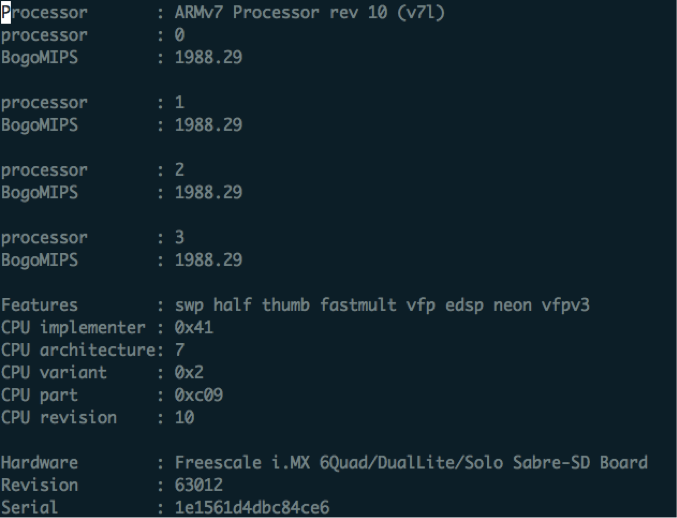
②输入vim /proc/meminfo
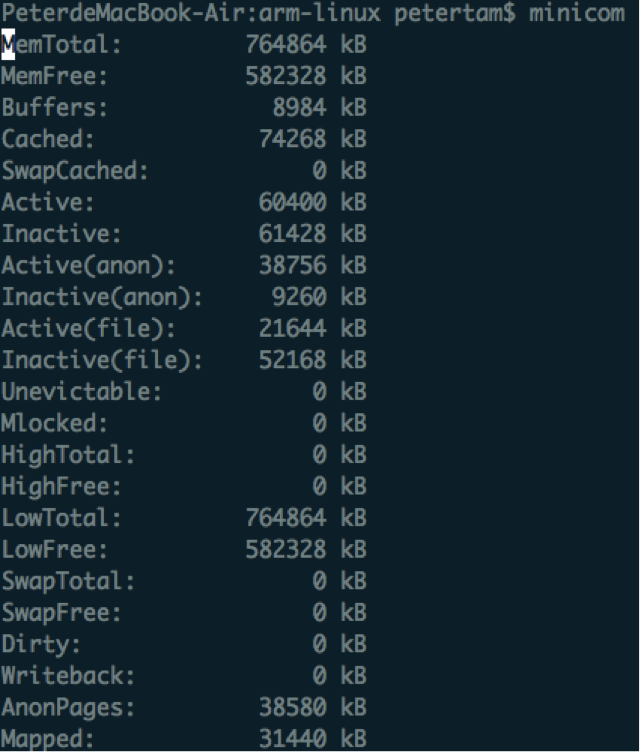
③输入vmstat

④输入观察硬盘信息

⑤输入fdisk观察分区情况
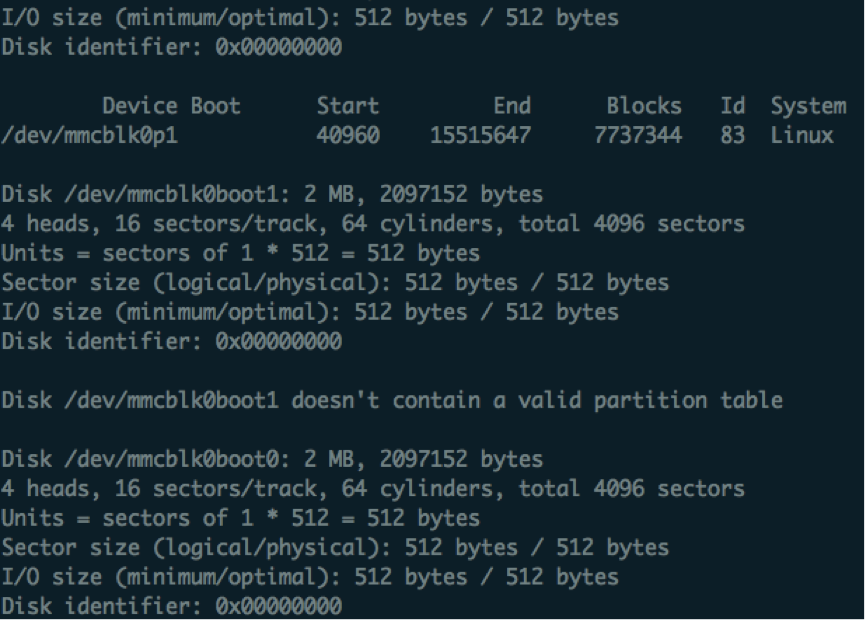
6、给出你的网络配置参数,截屏给出从pcDuino和PC两端得到的网络已连接的证明
网络配置参数如下
pcDuino Ping PC

PC Ping acadia

7、给出你的SSH配置文件,并解释其中内容
下面是位于pcduino的/etc/ssh/ssh_conf中的内容# This is the ssh client system-wide configuration file. See # ssh_config(5) for more information. This file provides defaults for # users, and the values can be changed in per-user configuration files # or on the command line. # Configuration data is parsed as follows: // 配置选项生效的优先级 # 1. command line options // 命令行选项 # 2. user-specific file // 用户指定文件 # 3. system-wide file // 系统范围的文件# Any configuration value is only changed the first time it is set. # Thus, host-specific definitions should be at the beginning of the # configuration file, and defaults at the end. # Site-wide defaults for some commonly used options. For a comprehensive # list of available options, their meanings and defaults, please see the # ssh_config(5) man page. Host * 选项“Host”只对能够匹配后面字串的计算机有效。“*”表示 所有的计算机。 # ForwardAgent no 设置连接是否经过验证代理(如果存在)转发给远程计算机 # ForwardX11 no 设置X11连接是否被自动重定向到安全的通道和显示集 # ForwardX11Trusted yes 是否允许转发X11会话 # RhostsRSAAuthentication no 设置是否使用RSA进行rhosts的安全验证 # RSAAuthentication yes 设置是否使用RSA进行安全验证 # PasswordAuthentication yes 设置是否需要口令验证 # HostbasedAuthentication no # GSSAPIKeyExchange no # GSSAPITrustDNS no # BatchMode no # CheckHostIP yes # AddressFamily any # ConnectTimeout 0 # StrictHostKeyChecking ask # IdentityFile ~/.ssh/identity # IdentityFile ~/.ssh/id_rsa # IdentityFile ~/.ssh/id_dsa # Port 22 sshd的监听端口号,默认为22 # Protocol 2,1 # Cipher 3des #Ciphersaes128-ctr,aes192-ctr,aes256-ctr,arcfour256,arcfour128,aes128-cbc,3d es-cbc # MACs hmac-md5,hmac-sha1,umac-64@openssh.com,hmac-ripemd160 # EscapeChar ~ # Tunnel no # TunnelDevice any:any # PermitLocalCommand no # VisualHostKey no # ProxyCommand ssh -q -W %h:%p gateway.example.com SendEnv LANG LC_* HashKnownHosts yes GSSAPIAuthentication yes GSSAPIDelegateCredentials no
8、存在多个登陆时,如何看到不同端口的登陆,给出截屏结果
PC上ssh pcduino
用w命令观察多个端口登陆的情况

9、给出嵌入式板卡上的SAMBA配置文件内容,并逐行解释
输入vim /etc/samba/smb.conf可以观察到配置内容。#======================= Global Settings ======================= [global] samba服务器的全局设置,对整个服务器有效 ## Browsing/Identification ### # Change this to the workgroup/NT-domain name your Samba server will part of workgroup = WORKGROUP 设定工作群组 # server string is the equivalent of the NT Description field server string = %h server (Samba, Ubuntu) 设定 Samba Server 的注释 # Windows Internet Name Serving Support Section: # WINS Support - Tells the NMBD component of Samba to enable its WINS Server # wins support = no 设定samba server 是否想网络提供WINS服务,通常无特殊原因设为no。 # WINS Server - Tells the NMBD components of Samba to be a WINS Client # Note: Samba can be either a WINS Server, or a WINS Client, but NOT both ; wins server = w.x.y.z 设定samba server 是否要使用别台主机提供的WINS服务,通常无特殊原因设为no。 # This will prevent nmbd to search for NetBIOS names through DNS. dns proxy = no 设定dns代理 #### Networking #### # The specific set of interfaces / networks to bind to # This can be either the interface name or an IP address/netmask; # interface names are normally preferred ; interfaces = 127.0.0.0/8 eth0 说明了网络接口 # Only bind to the named interfaces and/or networks; you must use the # 'interfaces' option above to use this. # It is recommended that you enable this feature if your Samba machine is # not protected by a firewall or is a firewall itself. However, this # option cannot handle dynamic or non-broadcast interfaces correctly. ; bind interfaces only = yes 是否是连接已经命名的接口和网络 #### Debugging/Accounting #### # This tells Samba to use a separate log file for each machine # that connects log file = /var/log/samba/log.%m 设置日志 # Cap the size of the individual log files (in KiB). ……中间是各种设置 下面是自己定义的共享位置 [share] path = "/etc/share" 自己共享的路径 available = yes 是否可以 public = yes 是否公用 browseable = yes 是否能够浏览 valid users = public smbuser guest ok = yes 客人能够访问吗 writable = yes 可写吗
10、给出用各种方式传递文件的过程,并从易用性、速度、安全等方面做比较

11、给出你所选择的交叉编译环境的情况:来源、安装过程等
本机是MacBook,用的是X86指令集的指令集。我们的目标是在自己的笔记本上将程序编译成ARM上的可执行代码,因为pcDuino是ARM的。参考了相关的教程之后,我是这样设置我的X86->ARM环境的。从Github(地址附在后面)下载ARM GNU Linux编译工具链。经过了漫长的下载过程之后,我们需要新建一个磁盘映像,目的是为了提供一个对大小写敏感的环境。
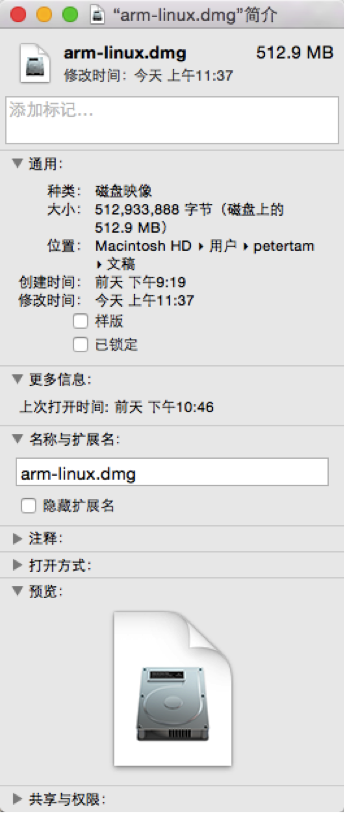
新建完一个映像之后。我们把压缩包解压到新的映像里面。

附工具链下载地址:
https://github.com/downloads/UnhandledException/ARMx/ARMx-2009q3-67.tar.bz2
12、给出交叉编译的程序的情况,并证明它是ARM/MIPS的可执行文件
首先自己写一个简单的程序。代码如下#include <stdio.h>
int main() {
printf(“Hello World!\n”);
return 0;
}然后运用特别的gcc工具进行编译。

生成了a.out,然而在本地是不能够运行的。

只有在arm的机子上,才能够正常运行。我们把这个二进制文件传送到pcduino上面,并尝试运行这个二进制文件。

13、给出嵌入式板卡本机开发环境的情况,给出一或两种语言编程的例子和结果
简单地进行C语言的编程。如上。
Python也可以

14、给出你尝试的远程图形桌面的方式:嵌入式板卡端的配置方法,PC端软件的获得,使用结果截屏等。
1、安装x11vnc 输入下面的命令: sudo apt-get install vino vinagre x11vnc 2、设置远程桌面登录时使用的密码,设置完后直接回车确认保存密码到 ~/.vnc/passwd 文件里。 输入下面的命令: sudo x11vnc -storepasswd 3、设置x11vnc通用的密码存储位置 输入下面的命令: sudo x11vnc -storepasswd in /etc/x11vnc.pass 4、将用户目录下的passwd文件内容copy到 /etc/x11vnc.pass下 输入下面的命令: sudo cp .vnc/passwd /etc/x11vnc.pass
在pcduino上的配置。其中5900是默认的端口。

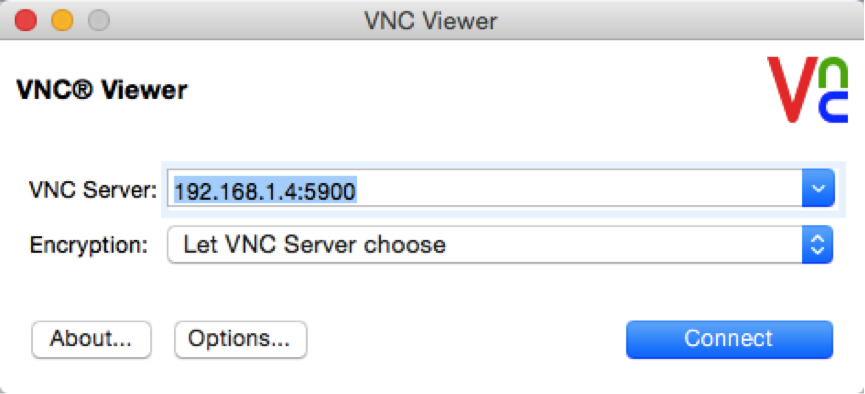
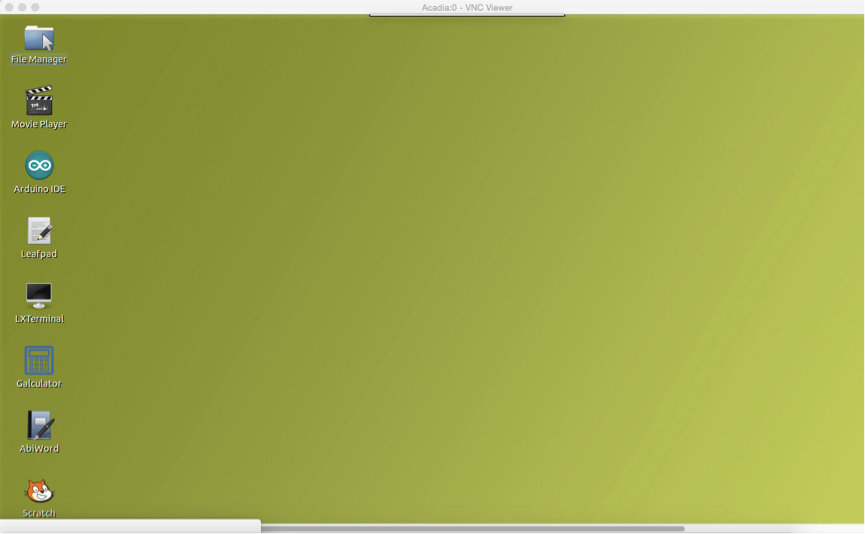
相关文章推荐
- 我的 ARM+Linux 学习路线
- 开发学习记录之看门狗驱动
- 时钟+温度+遥控设置,综合时钟例子
- Linux下运行openwebos- -(转)
- Linux下运行openwebos- -(转)
- BusyBox 简化嵌入式 Linux 系统
- EGL 学习
- 嵌入式开发设计方法变化的背景
- 嵌入式人才的发展方向
- 汇编调用c函数为什么要设置栈
- 三角函数的实现
- 嵌入式桌面操作系统使用与制作攻略
- 嵌入式系统烧写uboot/bootloader/kernel的一般方法
- 甲骨文收购Sleepycat 丰富嵌入式产品线
- 嵌入式Linux操作系统学习规划
- 基于嵌入式多芯片模组的微机保护平台
- 嵌入式系统中常用文件系统的制作总结
- 嵌入式C语言基础教程一
- 汇总Dotfuscator自定义规则中的元素选择
- 3. 类型限定符
